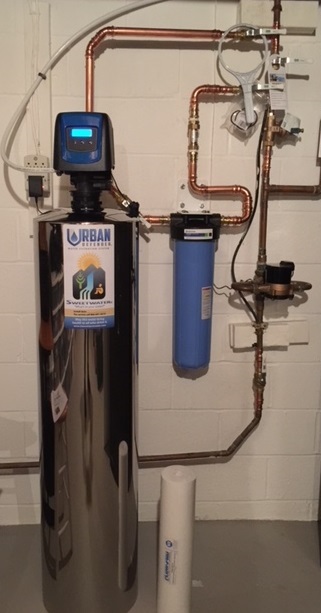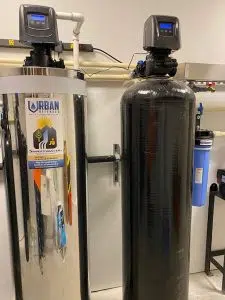Whole House Water Filter

Years of knowledge about water quality and my experience in water treatment went into the design. The Urban Defender™ is equal to products that cost three times the price and far superior to many of my competitor’s products that deprive you of effective treatment in order to appeal to you on price. I can’t name names, unfortunately, but I can tell you to avoid the cheap up flow carbon filters. You can email me and request an industry trade magazine article spelling out the reasons. The other, more recent, scam is promoting whole house water filters that have too many ‘stages’, meaning multiple treatments. These filters don’t have enough carbon, and the other stages don’t do anything useful.
Sweetwater's Urban Defender™
Extremely Effective – Great Value


Learn how it works! To learn what design features I use, request the Urban Defender specifications to learn how it works. This description includes the seven features to look for when choosing a whole house water filtration system:
Inquire Now: Send me your Urban Defender specifications and pricing
The Urban Defender is custom built, and I can modify each unit to match the chemicals in your water and the needs of your household. Hundreds of people now enjoy healthy showers using the Urban Defender. If I could make it even better, I would… Each year I take time out to research how I can improve the filter system and while I have made minor adjustments I am extremely pleased with the construction and effectiveness of the filter system components. Read below why I think it is the best water filtration system for your family.
Pricing:
Urban Defender™ with GAC: $2340.
Urban Defender™ with catalytic carbon: $2565.
Super Size (4 cu ft) Urban Defender™ for large homes/multiple showers: $4725.
An 8 cu ft Urban Defender™ for really large homes, bed and breakfasts, or commercial use: $6250. – price subject to change
5 micron pre-filter: $205. – always recommended
Optional add on filters:
Fluoride filter: see here – for whole house fluoride filters
Zeolyte (for trace levels of iron and manganese) filter: $325. (subject to change due to market conditions)
UV light: $1376. – whole house UV light, email me for specifications
You may also wish to use a water softener or the water revitalizer but whether or not I recommend these depends on what is in your water report as well as the priorities of individuals in your household.
To learn what you need start by finding your local water report and then calling me during business hours. We’ll review it together and determine what suits your family. Don’t fall for the cheap up flow filters that fail to remove all carcinogens.
The Urban Defender will remove the chlorine or chloramine and the carcinogenic chemicals, including the hard to remove trihalomethanes and haloacetic acids (look for those in your water report) in municipal water supplies. The trihalomethanes are absorbed by your skin and inhaled in the shower. They are among the most lethal contaminants we are exposed to daily. The Urban Defender will also remove the pesticides from farming. Showering in water with pesticides has been linked to breast cancer. Shower in water from which these carcinogens have been removed!
“Among the THMs that result from chlorine combining with organic compounds in water are carcinogenic chloroform and carbon tetrachloride. It is the combination of chlorine and organic materials already in the water that produces cancer-causing byproducts. The more organic matter in the water, the greater is the accumulation of THMs” – Read the paper at the link below.
The Urban Defender water filtration system removes or reduces: volatile and semi-volatile organic compounds such as chloramine, chlorine, alachlor, atrazine, trihalomethanes, haloacetic acids, solvents such as benzene and MTBE, soluble metallic and non-metallic ions including but not limited to arsenic, cobalt, antimony, copper, mercury, cadmium, chromium, lead, chloroform, hydrogen sulfide, lindane, malethion and other pesticides, silver, and trichlorethane. If you have significant levels of any of these metals then I will recommend the addition of a reverse osmosis system at the kitchen sink because we want to be able to maintain high flow rates with the Urban Defender and that limits its effectiveness at removing metals.
“My Urban Defender has changed my life. I love it!”
Aileen Gee; Falmouth, MA
The Urban Defender™ is available with catalytic carbon to remove chloramines or granular activated carbon (GAC) to remove chlorine or pesticides. Learn about choosing the correct size system.
All orders are by phone but you may request detailed specifications by email: Send me your Urban Defender specifications and pricing
Urban Defender whole house water filtration system with five micron pre-filter mounted in a garage.
If your water contains chloramines, a toxic combination of chlorine and ammonia now in use by many cities, then you need the catalytic carbon version. If your city uses chlorine then the GAC version will work just fine. Should you want to be able to use more than two showers at any one time then you need to use the Super Size version which has a higher flow rate.
The Urban Defender media is tailored to your water, the features, such as downflow filtration and the amount of carbon I use, make it effective at removing contaminants, and the quality of its components are the best in the industry. Mostly though I can honestly say that it is the best and most effective because I look at your water report as we talk, and I build the system that will serve the needs of your family. If I could make it even better, I would.
“San Francisco recently changed its water treatment and many of my neighbors were complaining about the color, taste, smell …. but we have the Urban Defender whole house filter and the Kitchen Defender (under the sink), and I truly never noticed a change. Our water is as tasty as ever.”
Jessica M-San Francisco
The seven features that make the Urban Defender™ the best whole house water filter in America today:
First, the Urban Defender is a Downflow system, which means that the water flows down through KDF media and 2 cubic feet of carbon chips forcing the contaminants to come in contact with both media types, thus maximizing effective removal.
Second, periodic backwash reshuffles the carbon to present new carbon surfaces to incoming water, maintaining effectiveness throughout the five to seven year life of the initial media.
Third, you can choose between catalytic carbon for chloramine removal or granular activated carbon (GAC) for chlorine removal.
Fourth, the 2 cu ft Urban Defender is limited to a flow rate of 10 gallons per minute – allowing for sufficient contact time between water and carbon to ensure removal of contaminants for the typical family home.
Fifth, for larger homes or homes where a higher flow rate is desired a larger version is available. The important factor in this choice would be the number of showers or water features you wish to operate simultaneously. The size of the house itself doesn’t actually matter. The Urban Defender costs more than the cheap up flow systems that don’t work well because it out-performs them due to its design.
Sixth, the Urban Defender is reusable, meaning that when the carbon is saturated with contaminants you can easily replace the media.
Seventh, I use media that has been certified by NSF (42 and 61) but I don’t make phony claims about how long the system will last or what it will do. What I do claim is an effective life of 500,000 gallons. This includes effective removal of the array of contaminants listed above. The companies that make claims of 3 million gallons are only talking about chlorine. The other carcinogens will be in your water after 500,000 gallons.
For a comparison to other water filtration systems, visit:
Finally, I can provide numerous pre or post treatment filter options to remove or reduce the other contaminants in your water – if necessary. One thing that most people do not understand is that a whole house water filter, made by any manufacturer, does NOT remove all the contaminants in your water. It removes those contaminants that makes your water better suited for showering and bathing by removing contaminants that are absorbed by the skin or inhaled. You may need additional treatment with a kitchen water filter as well, depending entirely on what’s in your water.
The Urban Defender will outperform and out last competitors’ systems. It is far superior to non-backwashing, up flow systems and equal in effectiveness to more expensive competitors backwashing systems while costing you less.
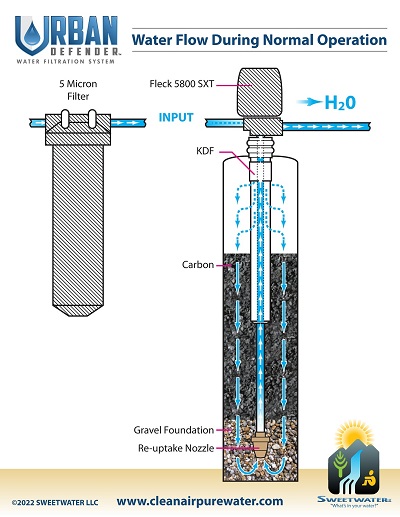
As you can see from the diagram all of the incoming water is treated by a downflow design. The purpose of the backwash then is to reshuffle the media in order to provide new carbon surfaces to the water as well as to eliminate channeling. This design maximizes contaminant removal.
I really encourage you not to be swayed by the lower price and false claims made about downflow systems that do not backwash or up flow systems. While tempting on price, these systems will not last long and you will end up having to replace them sooner. An honest estimate of their longevity is one fifth of the gallons they claim. Their lack of effectiveness is known throughout the industry and not just a statement made by me.
And you may request an explanation on why a downflow design with backwash is better than an up flow carbon filter: Backwash vs Up flow. They really are. Once again, this entire issue comes down to the question of who you can trust to sell you an effective product. Look at my testimonials. With the products I sell you are getting the very best that money can buy.
The Urban Defender may also be combined with Ultraviolet light, a water softener, nitrate or iron removal, or an array of backwashing water filters to provide you with the best whole house water filter system – comprehensive and effective; all based on a review of your water report and the contaminants that must be removed to provide your family with healthy water.
Send me your Urban Defender specifications and pricing
I do not sell products over the internet and there is no shopping cart on this site. To order, you call me, and we will review your city’s water report, discuss your goals, and determine which product will best meet your needs. My phone number is in the top right-hand corner of this page.
Urban Defender Product Reviews:
“Because I have chemical sensitivities, allergies, and other health challenges, I need the cleanest water. Jim and I discussed my particular requirements and sensitivities and arrived at a customized set of components for a whole house water filtration system, showering, and drinking. I intentionally waited a year after the installation to have the water analyzed by a national lab to see if the water filter system components were each still doing a good job, even at the point in time when replacement water filters were due. The tests came back with results that were near perfect: in all cases contaminants were below the national standard, and no contaminants and bacteria could be detected at all for the drinking water. This is the best whole house water filter because after many years and several systems the Urban Defender allows me to have peace of mind about my water. Thanks for your help and caring.”
Diane, Asheville, NC
“It has been almost 2 years since we purchased and installed the “Urban Defender” and I can now without hesitation offer you my unqualified statement of satisfaction. The Urban Defender completely transformed the quality of our drinking water, which now is pure tasting goodness. To say we are thrilled is an understatement! Maintenance — the simple annual replacement of the system’s 5 micron filter — is a snap and cost effective. I congratulate you on a fantastic product and will continue to tell friends and associates about the benefits of clean and pure drinking water. You know your stuff. Sincerely,”
David J. Peebler Montclair, NJ
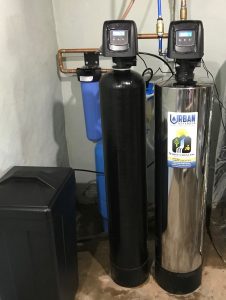
To see how my Urban Defender compares to other popular models, visit:
A Comparison of Whole House Water Filtration Systems
This comparison shows that the Urban Defender is equal in contaminant removal to whole house water filters that cost three to five times as much. I am confident that your choice of the Urban Defender is the best choice for the health of your family. If I could make it even better….I would.
Send me your Urban Defender specifications and pricing
4 cu ft Urban Defeder with fluoride filter
The benefit of a larger size Urban Defender is that you can use more water in the home and still remove carcinogens
“What an amazing difference! We used to have a chlorine smell every time we opened the tap, now we have amazingly clean, odor free water. We purchased the Urban Defender with the additional fluoride filter, as well as Sweetwater’s custom reverse osmosis system. The end result was that our water not only tastes fantastic but also feels great too!
Sweetwater’s Urban Defender® is the best whole house water filter because of its effective removal of contaminants and the facts about your water and home that go into the construction of each unit – custom built just for you. I have numerous systems in San Francisco, Oakland, Los Angeles, Denver, Chicago, Texas, Florida and other locations. Email or call to inquire
I always recommend that you use a 5 micron pre-filter. Here’s a look at one after 6 months of Madison, WI water:
When you call, you’ll reach me directly.
Together, we will solve the water problems in your home.
Toll-free: 866-691-4214
Direct: 970-259-2171
Monday thru Friday 9 AM to 5 PM Mountain Time
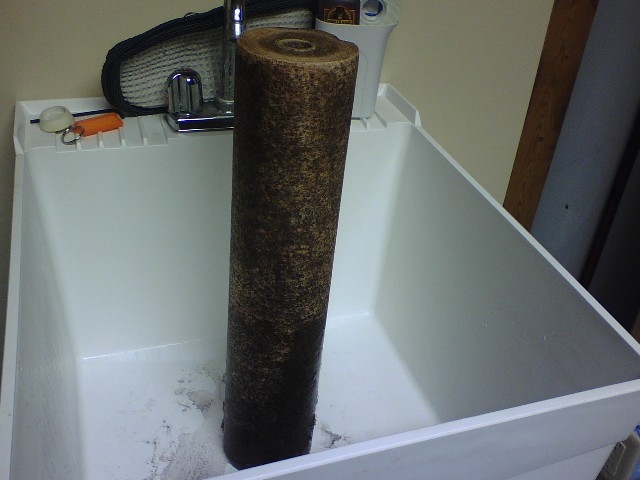
Search
Contact Jim
- 866-691-4214
- 970-259-2171
- Mon - Fri, 9 - 5, Mountain Time
- Monday - Friday
- jim@cleanairpurewater.com
Follow us
Products
Well Water Systems Well water purification systems and well water tests to meet YOUR needs
Kitchen Defender the very best water filter to remove chloramine and fluoride
Urban Defender® The most effective whole house water filter
Air Purifier. The air purifier uses ions
to remove particles from indoor air
Free E-Course
Five Steps to Healthy Water
Are you looking for a home water purification system or a kitchen water filter and wondering how to find your way through all the hype?
Avoid the Mistake Most People Make
Learn how to buy the correct water purification system or water filter.
SIGN UP FOR MY FREE E Course:
Get The Newsletter
Sign up for updates and special offers!
Thank you!
You have successfully joined our subscriber list.
Sign Up For The Water For Life Email List
Signup for news and special offers!
Thank you!
You have successfully joined our subscriber list.
I Guarantee It! (I hate spam too and I DO NOT sell or rent your email)
Great Tasting Healthy
If you're ready to have great tasting, healthy water here's what to do:
Obtain a copy of your city's annual water quality report (also known as a Consumer Confidence Report)
Here's how to find it:
Finding Your
Water Quality Report
or call me and we'll find it together online and discuss how to achieve healthy water for your family.
866-691-4214
I provide the home water purification systems, water filter, water purifier, or well water filter system that will meet your needs.
or
if you’d like to resolve your water purification issues all on your own and still be sure you’re making the right choice, you can….
Purchase My
Ultimate Guide To Selecting The Perfect Water Treatment System for just $14.95
Product Reviews
The iron system is fine; our water is clean and the toilets aren’t stained. My bride is happy! As a matter of fact, the system seems to have had a softening effect on our water – a fringe benefit we hadn’t expected but are happy to have.
